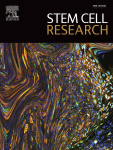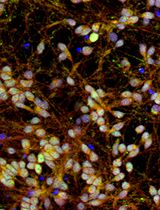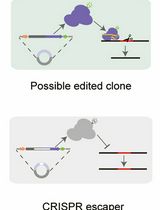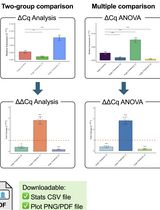- EN - English
- CN - 中文
Gene Expression Analysis in Stem Cell-derived Cortical Neuronal Cultures Using Multi-well SYBR Green Quantitative PCR Arrays
使用多孔 SYBR Green 定量 PCR 阵列在干细胞衍生的皮质神经元培养物中进行基因表达分析
发布: 2022年07月20日第12卷第14期 DOI: 10.21769/BioProtoc.4476 浏览次数: 3277
评审: Salma MerchantValerie UytterhoevenAnonymous reviewer(s)
Abstract
To optimize differentiation protocols for stem cell-based in vitro modeling applications, it is essential to assess the change in gene expression during the differentiation process. This allows controlling its differentiation efficiency into the target cell types. While RNA transcriptomics provides detail at a larger scale, timing and cost are prohibitive to include such analyses in the optimization process. In contrast, expression analysis of individual genes is cumbersome and lengthy.
Here, we developed a versatile and cost-efficient SYBR Green array of 27 markers along with two housekeeping genes to quickly screen for differentiation efficiency of human induced pluripotent stem cells (iPSCs) into excitatory cortical neurons. We first identified relevant pluripotency, neuroprogenitor, and neuronal markers for the array by literature search, and designed primers with a product size of 80-120 bp length, an annealing temperature of 60°C, and minimal predicted secondary structures. We spotted combined forward and reverse primers on 96-well plates and dried them out overnight. These plates can be prepared in advance in batches and stored at room temperature until use. Next, we added the SYBR Green master mix and complementary DNA (cDNA) to the plate in triplicates, ran quantitative PCR (qPCR) on a Quantstudio 6 Flex, and analyzed results with QuantStudio software.
We compared the expression of genes for pluripotency, neuroprogenitor cells, cortical neurons, and synaptic markers in a 96-well format at four different time points during the cortical differentiation. We found a sharp reduction of pluripotency genes within the first three days of pre-differentiation and a steady increase of neuronal markers and synaptic markers over time. In summary, we built a gene expression array that is customizable, fast, medium-throughput, and cost-efficient, ideally suited for optimization of differentiation protocols for stem cell-based in vitro modeling.
Background
The real-time quantitative PCR (qPCR) technique detects amplification of target nucleic acid sequences, and it is considered sensitive, reproducible, and specific (Arya et al., 2005).
Here, we use multi-well qPCR assays to amplify multiple genes with SYBR Green technology (Arikawa et al., 2011). SYBR Green is a DNA binding dye that binds non-specifically to double-stranded DNA (dsDNA) (Boone et al., 2015).
Based on the RT2 ProfilerTM array (Arikawa et al., 2011), we designed a multi-well SYBR Green qPCR panel to analyze the expression of genes involved in the differentiation of cortical neurons from the human iPSCs by forced expression of Neurogenin 2 (Ngn2), which is a neuronal transcription factor supporting neuronal differentiation of human embryonic stem cells or iPSCs into cortical-like neurons (Zhang et al., 2013). Here, we used a human iPSC line with a doxycycline-inducible mouse Ngn2 transgene engineered into a safe harbor locus (Wang et al., 2017). We collected cells at different time points (iPSCs, Day 0 pre-neurons, Day 15, and Day 30 cortical neurons) and analyzed genes that mark pluripotent stem cells, intermediate neuroprogenitors, and mature cortical neurons on a single 96-well plate. The amplicons/ primers were designed in the range of 80-120 bp, and the Tm was between 63°C and 66°C. The in-house preparation of the multi-well SYBR Green qPCR assay allows tailoring primers to specific experiments and assay modification as needed. This multi-well SYBR Green qPCR assay can be used for the quantitative analysis of any set of genes of interest. Different RT2 profiler arrays for pathway analysis are commercially available; however, none of them are optimized to follow the maturation of cortical neurons derived from iPSCs. We show that the multi-well SYBR Green qPCR is easily adaptable for customization in the laboratory. It is an economic platform and ideally suited for the optimization of differentiation protocols for in vitro stem cell modeling.
Materials and Reagents
RNA extraction
Homogenizer spin column (Thermo Fisher Scientific, Life Technologies, catalog number: 12183-026)
2-mercaptoethanol (Sigma-Aldrich, Aldrich Chemistry, catalog number: M2650)
DNase I, amplification grade (Thermo Fisher Scientific, Invitrogen, catalog number: 18068015)
Ethanol, molecular grade (Thermo Fisher Scientific, catalog number: BP2818500)
PureLinkR RNA mini kit (Thermo Fisher Scientific, Life Technologies, catalog number: 12183025)
RNase away (Thermo Fisher Scientific, Life Technologies, catalog number: 10328011)
cDNA Reverse Transcription
MicroAmp 8-tube strip (Thermo Fisher Scientific, Applied Biosciences, catalog number: A30589)
High-Capacity cDNA Reverse Transcription Kit (Thermo Fisher Scientific, Invitrogen, catalog number: 4368814)
Multi-well PCR reaction
MicroAmp Optical 96-well reaction plate (Thermo Fisher Scientific, Applied Biosystems, catalog number: N8010560)
MicroAmp Optical adhesive film (Thermo Fisher Scientific, Applied Biosystems, catalog number: 4311971)
Nuclease-free water (US Biological LifeSciences, catalog number: W0900)
PowerUpTM SYBRTM Green master mix (Thermo Fisher Scientific, Applied Biosystems, catalog number: A25780)
Consumables
1.5 mL and 0.6 mL RNase-free microcentrifuge tubes
RNase-free filter pipette tips (P1000, P200, P20, and P2)
Others
10× PBS, molecular grade (Fisher Scientific, catalog number: J75889K2
Accutase (Thermo Fisher Scientific, catalog number: NC9464543)
Bucket with wet ice
Personal protective equipment (gloves, lab coat, goggles)
Equipment
Revco Ultima II ultra low temperature -86°C freezer (Thermo Scientific, catalog number: ULT2586-9)
Microcentrifuge 5415C (Eppendorf, catalog number: M7282)
Refrigerated centrifuge (Beckman Coulter, catalog number: GS6 Allegra)
Mini centrifuge (Fisher Scientific, catalog number: 05-090-100)
Water bath (Thermo Fisher Scientific, Cole Parmer, catalog number: TSGP20)
MiniAmpTM thermal cycler (Applied Biosystems, Thermo Fisher Scientific, catalog number: A37834)
NanoDrop spectrophotometer (Thermo Fisher Scientific, catalog number: 13-400-525)
QuantStudio 6 Flex (Applied Biosystems, Thermo Fisher Scientific, catalog number: 4485691)
Optional: PlateR visual pipetting aid tablet (Biosistemika, catalog number: P-10)
Software
Beacon Designer (Premier Biosoft, http://www.premierbiosoft.com/qOligo/Oligo.jsp?PID=1)
In silico PCR prediction (UCSC Genome Browser, https://genome.ucsc.edu/cgi-bin/hgPcr)
Primer3 software (Whitehead Institute for Biomedical Research, Steve Rozen, Maido Remm, Triinu Koressaar, and Helen Skaletsky, https://bioinfo.ut.ee/primer3-0.4.0/)
QuantStudio Flex 6-v1.7.1 (Applied Biosystems, ThermoFisher Scientific, https://www.thermofisher.com/us/en/home/global/forms/life-science/quantstudio-6-7-flex-software.html)
UNAFold (Integrated DNA technology, https://www.idtdna.com/UNAFold). Create an account to use the software
Procedure
文章信息
版权信息
© 2022 The Authors; exclusive licensee Bio-protocol LLC.
如何引用
Srinivasaraghavan, V. N., Zafar, F. and Schuele, B. (2022). Gene Expression Analysis in Stem Cell-derived Cortical Neuronal Cultures Using Multi-well SYBR Green Quantitative PCR Arrays . Bio-protocol 12(14): e4476. DOI: 10.21769/BioProtoc.4476.
分类
干细胞 > 多能干细胞 > 细胞分化
神经科学 > 神经系统疾病 > 细胞机制
分子生物学 > DNA > 基因表达
您对这篇实验方法有问题吗?
在此处发布您的问题,我们将邀请本文作者来回答。同时,我们会将您的问题发布到Bio-protocol Exchange,以便寻求社区成员的帮助。
Share
Bluesky
X
Copy link












